History Women and History Men: the politics of women’s history by Mary Cullen
Published in
18th-19th Century Social Perspectives,
18th–19th - Century History,
20th Century Social Perspectives,
20th-century / Contemporary History,
Features,
Home Rule,
Issue 2 (Summer 1994),
Volume 2
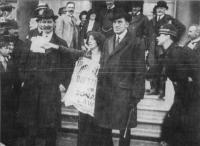
Meg Connery of the Irish Women’s Franchise
League attempts to hand suffragist literature to
Bonar Law (left) and Edward Carson (right).
(COURTESTY OF THE NATIONAL LIBRARY OF IRELAND)
Current developments in women’s history did not just happen. They grew directly from the contemporary feminist movement. The roots of feminism lie in the behaviour-patterns societies have prescribed for women and men. While these have differed over time and place, feminism has always grown from women’s perception that the sex roles prescribed by their own society conflicted with their knowledge of themselves and with their development as autonomous persons.
The ‘feminine mystique’
The new wave of feminism which emerged in Western society around 1960 challenged the prevailing stereotype which insisted that every female, by virtue of her sex, was individually fulfilled and made her best contribution to society solely as a wife and mother, subordinating the development of other talents and leaving responsibility for the organisation of . society to males. The American Betty Friedan called this model the ‘feminine mystique’, and women around the globe recognised it as corresponding to what they knew in their own cultures. Feminist rejection of the feminine mystique was challenged by the assertion that history showed that women had always been satisfied with this role. Since history books seldom mentioned women at all, with the exception of a few monarchs and revolutionaries whose lives and careers hardly conformed to the mystique model, feminists turned to the historical evidence with the question: what did women do? The answers which have come so far, and they are only the beginning, raise wide-ranging challenges to establishment history. As feminist enquiry focuses on different areas of knowledge, history included, the first stage is seeing and saying that women are invisible in the knowledge and theory of the particular discipline. Next comes the search for ‘great’ women, individuals who have ‘achieved’ within the criteria by which men are judged to have ‘achieved’. From this the focus moves to the contribution of a wider range of women to political, social and intellectual movements which underlie patterns of continuity and change in societies. The fourth stage sees women as a group, defined by their shared female sex, demanding the attention of historians. This development has a radical potential to which this essay will return. The ultimate stage should be the writing of a new integrated history incorporating the historical experience of both sexes.
Invisible women?
Let us consider the implications of one early discovery by feminist historians, the women’s emancipation movements of the nineteenth and early twentieth centuries and the causes that gave rise to them. While feminist movements were neither the central nor the most important phenomena in women’s history, their existence allows us to bypass one regularly repeated explanation of the invisibility of women in the history books. Since women were not participants in public politics, historians, it was asserted, could hardly be blamed for not dealing with them. The women’s emancipation movement, a highly visible and international political movement, refutes this explanation. While laws, regulations and customs were not identical in all countries the position of women relative to men was fundamentally similar. In virtually every country in Western society, women were excluded from political life, whether by holding public office, or as members of parliaments, or as voters. They were barred from higher education and the professions. Titles and property passed to sons in preference to daughters. The home was seen as ‘the woman’s sphere’, yet, to take a representative example, under English common law, in force in Ireland, when a woman married her legal identity merged into that of her husband. Her property, whether earned or inherited, passed under his control to dispose of as he pleased and the law gave him full authority over her and their children. Divorce was considerably more difficult for a wife to obtain than it was for a husband, and if a woman left her husband his duty to maintain her lapsed while his right to her property did not. In sex-related offences such as adultery, prostitution and illegitimate birth, the law treated women as the more guilty and punishable party. In campaigns starting around the middle of the nineteenth century and continuing into the 1920s and 1930s, in country after country, feminists revolutionised the status of worrien by removing most of the legally imposed civil and political disabilities based on sex. By any standards it was a sizeable achievement even if with hindsight we know that the underlying stereotypes of ‘natural’ or ‘correct’ feminine and masculine behaviour were harder to shift.
No need to re-invent the wheel
One aspect of this rediscovered history of the women’s emancipation movement is its relevance to women’s self-knowledge today, its restoration of part of their lost group memory. It tells us that we have not been paranoid in perceptions of oppression, and that the problem of sexism has older and deeper roots than many have realised. On the more positive side, the better sexism is understood, the better the chance of eliminating it. Further, the history of the women’s emancipation movement establishes beyond argument that relations between the sexes, including relations of power, have not been unchanging throughout history and dispels the belief that women have always conformed happily to a ‘natural’ role of passivity and subordination. It places current feminism in context as part of a long historical process, rather than the historical aberration often suggested. Feminists today can start from the knowledge that women before them dissented from imposed patterns of behaviour and changed them. It frees them to build on what is already there instead of re-inventing the wheel in each new generation. It also raises the question of why all this had to be rediscovered in the first place. Why had it ever been lost? Why has the historical reality that the structures of Irish society included a systematic limitation of women’s autonomy and freedom of action, a limitation not applied to men, gone unrecorded in histories of Irish society? It is difficult to see why an organisation of society which gave men a monopoly of access to political and economic power, and excluded women from virtually every avenue of approach to these, should be something that historians have not seen as a Significant or important aspect of Irish society. It is equally difficult to see how feminist organisation to abolish sweeping civil and political disabilities could be regarded as more sectional, more trivial or less significant than, for example, nationalism or the labour movement. It appears that the answers are not to be found in the content of the historical record but in the minds of historians. If we dismiss a conspiracy theory of deliberate suppression, the explanation can only be that most historians have not seen women as important or ‘significant’ in the history of their societies. They have written history within a paradigm that sees men as the active agents in the patterns of continuity and change historians look for. This paradigm does not see women as an integral part of human society, but as peripheral and essentially outside history. Once the question ‘What did women do?’ was seriously asked, it became clear that this paradigm blinkered historians’ vision and distorted findings and interpretations.
Knowledge a human creation
Women’s history and feminist studies in general continually remind us that knowledge is not an objective given but a human creation. Historians do not exist in a vacuum but are members of a society, formed by it and influenced by its value systems. If they bring with them ways of looking at the world which see males as ‘doers’ and ‘leaders’ and females as ‘passive’ and ‘followers’ they are unlikely to look for evidence of action or change brought about by female initiative, and may fail to recognise its significance when found.
Value-free history?
This raises the question of bias in the writing of history. History written from the perspective of groups distant from centres of power and privilege, such as women’s history, labour history, Marxist history, black history, is often labelled as ‘political’ and liable to bias. The pitfalls of bias are real. As a feminist historian I am likely to want to find certain things, and there is always the temptation to search more assiduously for the evidence that supports one’s hypothesis than for that which refutes it. But knowing my bias puts me in a better position to be alert to this danger and to try to avoid it. Others too will be more alert to see and tell me if I fail. But historians who believe themselves to be value-free and ‘neutral’ are in more danger. An assumption that the current political or intellectual status-quo or orthodoxy is usually ‘right’ and those who dissent from it likely to be ‘wrong’ is as political a perspective as a feminist or Marxist one and, if unconsciously held, more likely to distort the way history is written. In my own case I am more concerned about the biases and value-systems I inevitably have, but of which I am not aware, than I am of feminist sympathies.
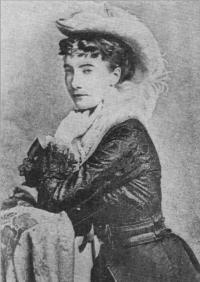
Fanny Parnell.
(COURTESY OF THE NATIONAL LIBRARY OF IRELAND)
Differences not simply due to ‘nature’ or ‘biology’
The realisation that women as a group have a history displaying patterns of continuity and change grew from the mounting evidence that differences in the relative position of men and women in societies could not all be attributed simply to ‘nature’ or ‘biology’. This can be illustrated by two examples from nineteenth-century Irish history – at one end of the social spectrum the landed family of the Parnells in County Wicklow in the second half of the century, and at the other end widowhood and illegitimate birth in the 1830s. The brother and sisters Charles, Fanny and Anna Parnell were all committed and active nationalists. Charles went to a public school and to Cambridge, inherited an estate, entered parliament and became the leader of a political party. All these stages in his life were open to him as a male. As females his sisters could not go to a public school, go to Cambridge, enter parliament or become leaders of political parties. The circumstances of Anna’s leader~ hiP of the Ladies Land League vividly Illustrate the differences. Fanny and Anna did not inherit estates but had incomes settled on them by their father and charged on the estate of another brother. These contrasts in the political, social and economic consequences of sex were not determi” ned by ‘biological’ difference but by the laws, regulations and customs which determined what males and females could and could not do at that place and time in history. At the other end of the social scale the Poor Inquiry of 1835-6 found among the categories of the destitute two which contained no men, but only women and children. These were widows with families of young children and illegitimate children and their mothers. Again, no direct biological imperative decreed that among the poorer classes widows, but not widowers, with young children, and illegitimate children and their moth~ rs, but not their fathers, were highly likely to be destitute. Here also the causes must be sought in the distribution of resources at that time and place, in who controlled that distribution and in whose interests, and within terms of what paradigm of SOCiety, class structure and male-female relationships.
Gender and sex
With the revelation that there have been real political, social and eco-nomic differences consequent on being born a male or a female at a particular time or place, and that these differences have varied from one society or culture to another and changed over time, sex emerged as a category of historical analysis. This was not sex in the sense of biological determinism but in the way societies create sex roles to which individuals are socialised or coerced to conform. The word ‘gender’ was drawn into use to denote the social construction of sex. Used with precision within specific historical contexts, gender is a valuable concept in historical research and interpretation. It focuses attention on the relationships between the sexes, how these are structured and maintained and how they change over time and place. It also directs atten-tion to relationships within the sexes, those between different groups of women and between different groups of men. It enables the historian to apply the concept of sex as a social construction in research and interpretation. Historical specificity also makes it clear that gender does not stand on its own as the only important analysis. It interacts with other factors such as class, colour, nationality, ethnic origin, political affiliation, religion, age, marital and parental situation and many more, in locating individuals or groups in their historical context. Feminist historians argue that, while gender is not the only essential analysis, it is one of the essential analyses, and that, if it is excluded, the picture drawn by the historian will be to a greater or lesser extent distorted. Thus defined and used, gender analysis forestalls reductionist interpretations that all women have shared the same history, or that women’s history is simply a history of the oppression of all women by all men. Women have been oppressors both as individuals and as members of oppressing classes or nations. Men have been oppressed, by other men and by women, as well as being oppressors. Women’s history is far more than oppression and resistance to it, important as both these aspects are.
Three dichotomies
The German historian Gisela Bock explains how feminist historians have challenged ‘three dichotomies in traditional thought on gender relations’, those of nature versus culture, work versus family, and public versus private. The nature versus culture dichotomy sees men and male activities as ‘culture’ and a proper subject of historical study, but sees women and female activities, especially those connected with sexuality, women’s bodies, pregnancy and motherhood, as ‘nature’, unchanging over time and place, and so outside the historian’s remit. Feminist research has challenged this by showing that the words ‘nature’ and ‘culture’ have not had fixed immutable meanings but have meant different things at different times and places and are in reality interrelated and interdependent. The second dichotomy sees family life not as ‘work’ but ‘natural’. But families were and are work places for most women, where they bear and raise children and care for family members. The bread-winner husband who supports his family is himself supported by his wife’s work. This switches attention to the more real dichotomy of the inequalities in the valuation and reward of women’s work and men’s work. Nor does the third dichotomy of public versus private withstand scrutiny. Men cannot operate as they have traditionally done in the public world without the support of the private world. As Bock pOints out, ‘male workers, male politiCians and male scholars perform their tasks only because they are born, reared and cared for by women’s labour’. Instead of men and women occupying separate worlds which proceed in parallel, there is only one world where the political, economic and social are interdependent, and where gender relations interact with all three.
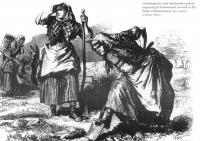
Contemporary mid nineteenth-century engraving of Irishwomen at work in the fields of Roscommon. (IlLUSTRATED LONDON N EWS)
The question of men in history
This brings to the forefront the question lurking in the background so far, the question of men in history. History as it has been written has been less the history of men than the history of the activities of privileged groups of men who occupied positions of public power. It has seldom looked at men as a group, the subset of humanity defined by their male sex. Just as the history of women can-not be written without reference to gender relationships, neither can the history of men. Women’s history has made it no longer tenable to see the male role in society as the human norm, from which women were for some reason, whether ‘biological’ inferiority, slower cultural development or whatever, left behind in human evolution and so had to try to catch up with men and attain the male role. The interdependence of the gender roles of the sexes rule out this interpretation. We do
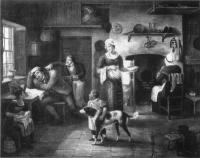
The family as a woman’s work place –
A kitchen interior by John Mulvany.
(COURTESY OF THE NATIONAL GALLERY OF IRELAND)
not yet know the extent of the re-evaluations to which this will lead. One will certainly focus attention on definitions of what is recognised as significant historical change and the respective contribution to it by individuals or groups in positions of public power and by individuals and groups far distant from such locations. They are also likely to include reassessment of the contribution of the full-time male politicians, intellectuals, artists, soldiers, revolutionaries or whatever who have been all these full-time because of women’s work. Male privilege, control of resources and freedom from daily family responsibility undermine theories which incorporate the idea of the ‘naturalness’ of male ‘achievement’ and which cite in support the relative paucity of similar female achievement.
Male monopolies
Instead of asking why women have dissented, it might be more useful in increasing our understanding of the past to ask why male elites have so consistently tried to keep control of wealth, education and political power as male monopolies, and to limit women’s freedom of action by expanding their childbearing capacity into a life-time career devoted exclusively to care of family and home at the expense of any serious participation in the affairs of society at large or sustained commitment to intellectual or artistic endeavour. Can the pronouncements by so many of the ‘great masters’ of Western philosophy on the intellectual and moral inferiority of women as compared to men continue to be dismissed as unimportant hiccups which do not affect the over-all evaluation of their systems of thought? By whose instigation and in whose interests did the dualities and theories of opposites that have bedevilled Western thought about the sexes come into being? Why has male identity so often been built on being different to and having control over women? What impact have male sexrole stereotypes which see aggression and dominance as acceptable or desirable masculine characteristics had on the history of different societies?
A new integrated history?
This leads on to the big question of how a more embracingly ‘human’ history will be written. Seeing relationships between the sexes as an integral part of the history of a society will be central. We can also hope that women’s history will carry into all areas of research and interpretation its concern with the origin and operation of systems of power and control,as well as its openness to the complexities of human experience and to the danger of imposing absolutes and dichotomies, not only when dealing with women and men but throughout the search for the past. Who then is going to write the new integrated history and when? One view is that first we need to build a sufficient base of publication in women’s history to provide a firm foundation. Then, once a critical mass of knowledge and theory has been reached the patriarchal paradigm at present in possession will collapse under the weight of the increasing mass of contrary evidence, and leave the way open for a new paradigm within which historians can rewrite history.
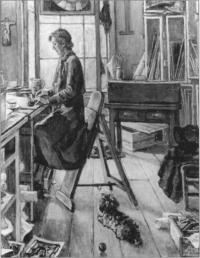
Evie Hone at work in her studio by Hilda van Stockun.
(COURTESY OF THE NATIONAL GALLERY OF IRELAND)
The misuse of ‘gender’
Some recent developments suggest that vigilance may be needed to prevent the radical potential of women’s history being diverted into a cuI de sac. These include a tendency to misuse ‘gender’ as a synonym for ‘women’, a misuse which allows the essence of gender analysis, that sex is a social construct, to be bypassed and allows men as a group to again elude the historian’s scrutiny. This can produce a descriptive social history,valuable in the information it gives, but which does not ask the ‘hows’ and ‘whys’ which push social, economic and political history into engagement with each other. Particularly ironic is the emergence in the United States of ‘gender history’ as a rival to ‘women’s history’ and claimed to be more universal and less biased. Since women’s history led to the concept of gender history, it is hardly surprising that the sceptical see this new dichotomy as an attempt to neutralise the-challenge of women’s history by marginalising it as less than fully academically respectable. Here I believe the politics of women’s history come into play. Today’s women’s history, including the concept of gender, came from today’s feminism, a movement which asserts women’s autonomy and responsibility and challenges male and female sex-role stereotypes which limit these and which incorporate male dominance over women. The diversionary movements described above appear either to fail to understand the concept of sex as a social construct, or to fail to engage with it, and may be seen as elements of a counter-revolution. It is arguable that historians who do not understand current feminism will have difficulty in accepting that women’s history is ‘real’ history, and so a real part of human history, however well-intentioned they may believe themselves to be. For example, this seems the most plausible explanation for the way two of the most recent high-profile histories of Ireland, Foster’s Modem Ireland 1600- 1972 and Lee’s Ireland 1912-1985 deal with feminism. Foster tells us that the feminist movement is an ‘important’ topic, mentions feminists and feminism a number of times in the text, and yet gives the reader no information whatsoever as to what the objectives of feminism were, how feminists pursued them and what, if anything, they achieved. Lee makes no mention of feminism, either in the 1912-1922 period when it won the vote for women, after the founding of the Free State when it faced a reactionary backlash, or, perhaps most surpris-ingly, between 1970 and 1985 when the new wave of feminism was at its height. It may be going too far to suggest that women’s history and the new integrated human history can only be successfully written by feminists, whether they be women or men. However, I am convinced that, if the potential of women’s history is to be realised, the historians concerned need to at least understand feminism today, whether or not they agree with its analysis. Unfortunately it appears that most historians, like most people generally, see feminism as essentially women wanting to be like men, and so as a ‘women’s issue’ which need not involve men. Believing this is an effective defence against having to think about feminism seriously, and in particular about its challenge to men and male stereotypes
If my argument has any validity, it follows that, in tandem with the work of research and publication, we need a debate about the nature of women’s history and its methodologies and politics. The objective will be to put this debate on the agenda of historians of women and from there to move it on to the agenda of the wider community of historians.
Mary Cullen lectures in history at St Patrick’s College, Maynooth.
Further reading:
J. W. Scott, Gender and the politics of history (New York 1988). G. Bock, ‘Women’s history and gender history: aspects of an international debate’, Gender and History. vol. 1, no. 1 (Spring 1989). G. Bock, ‘Challenging dichotomies: perspectives on women’s history’, in K. Offen, R.R. Pierson and J. Rendall (eds.), Writing women’s history: international perspectives (London 1991). A fuller version of this article will shortly appear in D. 6 Ceallaigh, Reconsiderations of Irish history and culture (Leirmheas).





















